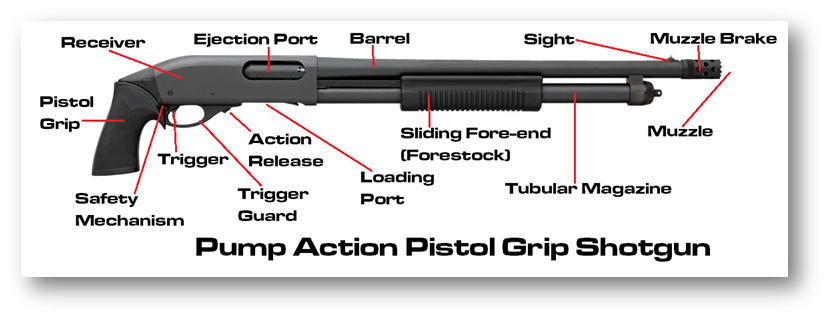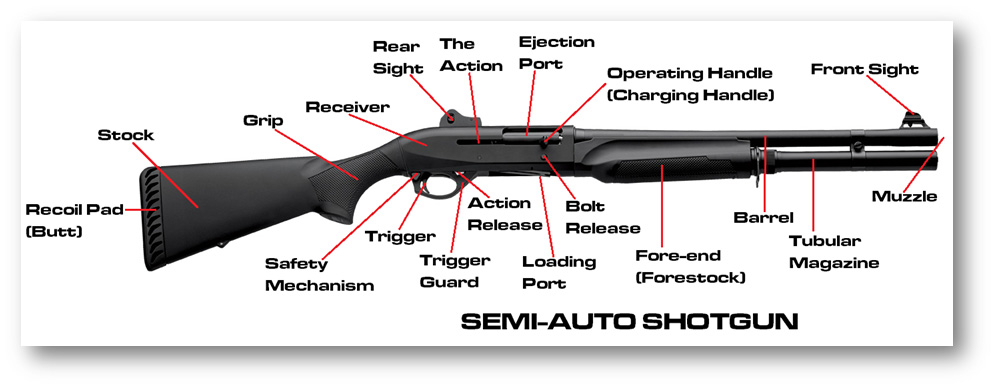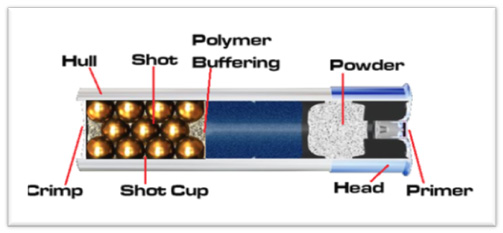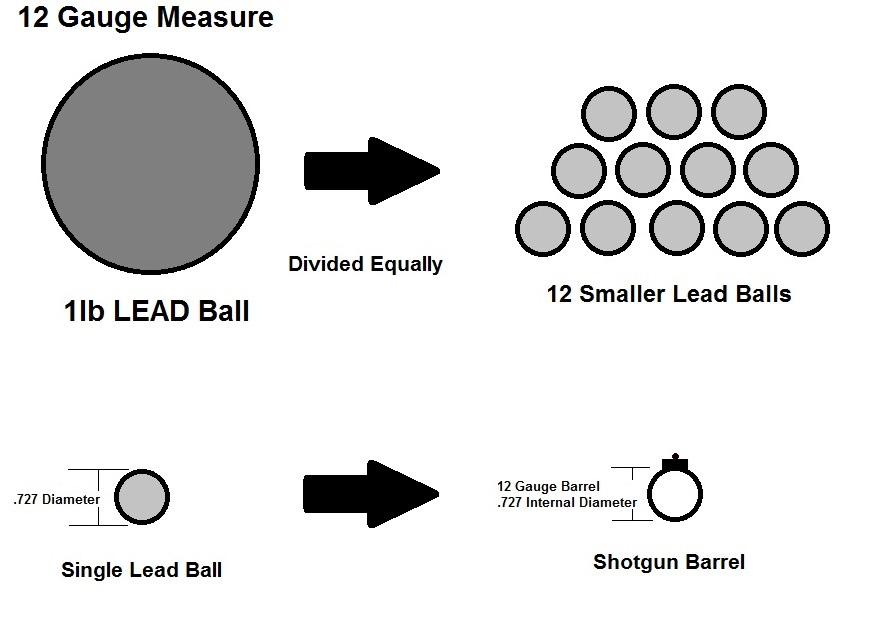SHOTGUNS
There are a wide variety of shotguns on the market today, each designed to perform a specific task, duty or purpose. The primary focus of a shotgun is to deliver a large & powerful payload in short distance situations.
Here, you will discover the basic nature of shotguns as well as the details of their particular functions. Please take a moment and review the basic knowledge of a shotguns action, parts & terminology, and ammunition.
The two (2) primary breeds of shotguns commonly circulated amongst firearm owners today are Pump-Action (or Slide-Action) and Semi-Automatic shotguns:
PUMP ACTION SHOTGUNS
-A shotgun having an action that extracts the empty case, loads, and cocks the gauge by means of a hand-operated lever that manually slides back and forth under the barrel; also referred to as a slide-action.
Pump-Action (Slide-Action) shotguns require a user to slide the action back and forth to load each shell, initiating the sequence of fire, which is where you get the common term "pump-action". These shotguns are manual, tend to be easy to operate and are typically "low maintenance" due to the simple mechanical operation.
SEMI-AUTOMATIC SHOTGUNS
A semi-automatic shotgun is a gauge capable of firing a shell after every trigger pull, without needing to manually chamber another round. These gauges commonly operate in gas, blowback or "recoil operation" to cycle the action, eject the empty shell and feed another round.
Semiautomatic shotguns utilize the stored inertia generated by the previous sequence of fire to mechanically eject the expended shell and then chamber a new shotshell. These weapons tend to generate less recoil, but can be harder to maintain, and require more proficiency to operate.
Now the lesson will cover the primary parts of a shotgun, so you can learn the mechanical operation as well as the correct terminology associated with these versatile weapons.
PRIMARY PARTS OF SHOTGUNS
Pump Action (Slide-Action) Shotgun
Receiver ‑ The receiver is responsible for holding all the mechanical parts together. These parts traditionally include the trigger housing, any mechanical safety(s) and the bolt or bolt carrier group. Unlike some rifles, shotguns tend to only have a single receiver.
Ejection Port ‑ An outlet in the receiver of a shotgun through which the spent shells are ejected from the chamber following a normal firing sequence.
Tubular Magazine ‑ A tubular magazine commonly found on pump-action shotguns, stores cartridges end-to-end inside of a spring-loaded tube running parallel to the barrel, or in the buttstock.
Barrel ‑ Simply, the discharging tube of a gun. The tubes are meticulously engineered and bored out to provide an exit path for the discharging shotshells. Once the projectile is fired, it's guided through the barrel bursting out the muzzle by expanding gas forces.
Muzzle ‑ The discharging end of a shotgun (end-point of a barrel) where the shotshell exits the gauge.
Sliding Fore-end ‑ Frequently referred to as a "Forestock", this is the forward grip of a shotgun. On pump-actionshotguns, the fore-end slides back and forth to load and unload (eject) shells to and from the shotguns chamber.
Loading Port ‑ A port to manually load shotshells into the tubular magazine.
Trigger ‑ A lever that is "pulled" or squeezed to initiate the firing sequence (discharge a cartridge).
Trigger Guard ‑ The portion of a firearms frame (receiver) that wraps around the trigger, providing for additional protection and safety.
Pistol Grip - A part of a pump action pistol grip shotgun connected to the rear of the receiver that is gripped by the hand, usually textured to provide additional traction for a firm hold of the shotgun.
Sight - a mounted sight on a shotgun nearest the muzzle; the sight is used in taking aim and target acquisition while sequencing the firing of a shotgun.
Safety - mechanism that is toggled to provide an extra safety measure; it locks the trigger, hammer and bolt from initiating the firing of the shotgun, and helps ensure prevention of a negligent discharge.
Action Release ‑ mechanism that is usually located near the trigger guard that acts as an unlocking mechanism allowing for the action bar and bolt to slide back and eject an undischarged chambered shotshell.
Muzzle Brake ‑ A muzzle brake, recoil compensator, or flash hider is a device connected to the muzzle (Barrel End) of a firearm and redirects propellant gases to counter recoil and unwanted rising of the barrel during the sequence of fire.

Semi-Automatic Shotgun
Receiver ‑ The receiver is responsible for holding all the mechanical parts together of a firearm. These parts traditionally include the trigger housing and bolt carrier group. Unlike other rifles, gauges tend to only have a single receiver.
Ejection Port ‑ An outlet in the receiver of a gauge through which the spent shells are ejected from the chamber following a firing sequence.
Tubular Magazine ‑ A tubular magazine commonly found on pump-action shotguns, stores cartridges end-to-end inside of a spring-loaded tube typically running parallel to the barrel, or in the buttstock.
Barrel ‑ Simply, the discharging tube of a gun that dictates direction of travel of the projectile. The tubes are meticulously engineered and bored out to provide an exit path for the discharging shotshells. Once the projectile is fired, it's guided through the barrel, out of the muzzle by the expanding gas forces.
Muzzle ‑ The business end of a shotgun (front end of the barrel) where the shotshell exits.
Fore-end ‑ Frequently referred to as a "Forestock", this is the forward grip of a shotgun. On pump-actionshotguns, the fore-end slides back and forth to both load and unload (eject) shells to/ from the shotgun chamber(s).
Loading Port ‑ A port to manually load shotshells into the tubular magazine.
Trigger ‑ A lever that is "pulled" or squeezed to initiate the firing sequence (discharge a shotshell).
Trigger Guard ‑ The portion of a firearms frame (receiver) that wraps around the trigger, providing for additional protection and safety.
Front Sight - a mounted sight on a shotgun nearest the muzzle (front end); the sight is used in taking aim and target acquisition while firing the shotgun.
Rear Sight ‑ a mounted sight on a shotgun nearest to the stock (back end); the sight is used in taking aim and target acquisition as well as assisting the operator in identifying the front-sight while sequencing the firing of a gauge.
Safety - a mechanism that is toggled to provide an extra safety measure; usually locks the trigger, hammer and bolt from commencing with the firing sequence of the shotgun, and ensuring prevention of a negligent discharge.
Grip ‑the area of a shotguns stock held by the operator's rear most hand.
Stock ‑ also referred to as a shoulder stock, buttstock, or a butt. The rearmost part of a shotgun, traditionally attached to the receiver or chassis, and held against one's shoulder when firing the shotgun. The stock enables the shooter to firmly support the device and comfortably aim. The stock also helps manage the recoil between the receiver and operator's body.
Recoil pad ‑ attaches to the "Butt" of the shotgun; is the rear most end that is pressed directly against the operator's shoulder and helps mitigate excessive recoil when the weapon is discharged.
The Action ‑ the mechanical operation of a semi-automatic shotgun, uses the force generated by the last shot to automatically eject the empty shell and chamber the next shotshell after each trigger pull.
Bolt Release ‑ refers to a mechanism traditionally located on the receiver on a semi/full automatic shotgun, used to release the bolt and or bolt carrier, allowing the weapon to be readied for firing.
Operating Handle (Charging Handle) ‑is a mechanical lever on a semi-automatic shotgun which, when manipulated, results in the hammer beingcocked or locked in the firing position and ready to initiate the sequence of fire. The charging handle has a number of necessary functions; it facilitates the ejection of a spent or unfired shotshell from the chamber; it can load a shotshell from the tubular magazine, or drum, or by hand into the chamber; it clears a stoppage such as a jam, double feed, stovepipe or misfire; it verifies that the shotguns chamber is clear of any shotshells or other obstructions; it moves the bolt in to battery, acting as a forward assist; it releases a bolt locked to the rear, such as would be the case after firing the last shotshell of the shotgun equipped with a last-shotshell-hold-open feature.
Action Release ‑ usually located near the trigger guard and acts as an unlocking mechanism allowing for the action bar and bolt to slide back and eject an undischarged chambered shotshell.

ACTION OF A SHOTGUN
The action of a shotgun consists of all the moving parts that allow the loading, locking, firing, extracting, and ejection of a spent shell of a shotgun and the process by which that mechanism functions through the sequence of fire. In this section, we'll take a moment to explore the basics of Pump-Action (Slide-Action) and Semi-Automatic action shotguns.
Pump-Action (Slide) ‑ In Pump-Action (Slide Action) guages, a forward grip traditionally referred to as the Fore-end or Forestock, is operated by the user to both chamber and eject shotshells, enabling the sequence of fire to begin. Although Pump Actions can also be found in rifles, they are predominantly found in shotguns.
After a shell is spent, the bolt unlocks and frees the Fore-end to be manually cycled. Manipulating the Fore-end to the rear cycles the action and extracts & ejects a spent shell after the sequence of fire, which in turn cocks the hammer to the ready position. A shotshell is then directed from the tubular magazine, drum or other ammo storage area and prepares it to be "fed" into the chamber. As the Fore-end is pushed forward, the lifter chambers a shotshell and aligns the round with the chamber. The bolt then slides forward and locks the shotshell in place in the firing position. The pull of the trigger will discharge a shotshell and reset the shotgun's action.
Semi-Automatic Action ‑ Semi-Auto gauge's function very much the same as pump-action shotguns. The main difference is the elimination of the manual action setting which sets all the steps for sequence of fire in motion. Unlike pump-action gauges, these shotguns use the energy from the recoil of the firing sequence to achieve the same results. The natural force generated when a shotshell is fired in conjunction with recoil springs, sends the shotgun through the same process automatically. These shotguns potentially can be less mechanically reliable than the standard pump-action models due to the increased complexity of the additional parts.
SHOTGUN AMMUNITION

Shotgun shells are a specific ammunition type that is usually applicable to shotguns only. Please refer to your shotguns "User's Manual" included with purchase, and identify the manufacturer's specific instructions for the proper shotgun shells & loads recommended & tested for the specific weapon's make & model.
A shotgun shell is a self-contained cartridge typically loaded with multiple metallic shot (small and generally spherical projectiles). Historically, lead was used, but modern shells are composed of various materials such as steel, tungsten or bismuth, which has replaced the use of lead entirely. A single, large projectile known as a shotgun slug is also commonly used. Numerous specialty cartridges such as less-lethal cartridges,beanbag cartridges,flechette cartridges, and lead-dust cartridges are also available contingent to intended use and helps make the shotgun a kind of "jack of all trades".
Most shotgun shells are designed to be fired through a smoothbore barrel, but some shotguns (i.e. Tactical Shotguns) have rifled barrels and may utilize a number of different cartridges. A rifled barrel will increase the accuracy of shotgun slugs, but makes it unsuitable for firing shotshells, as it imparts a spin to the shotshell cup, causing the shotshell cluster to disperse due to centrifugal force.
Shotshells are measured by a "Gauge" rather than calibers like other firearms. Shotshells come in varying sizes, loads, and shot including, but not limited to, different lengths. Not all shotguns fit the same length of shotshell, so it is important to know exactly what fits your firearm. Consult your manual.
|
Number of Lead Balls in One Pound |
Diameter of the Requisite Pure Lead Ball |
|
10 Gauge |
0.78" (19.7 mm) |
|
12 Gauge |
0.73" (18.5 mm) |
|
16 Gauge |
0.66" (16.8 mm) |
|
20 Gauge |
0.62" (15.6 mm) |
|
28 Gauge |
0.55" (14.0 mm) |
Shotgun Shell Glossary

Action ‑ The mechanism of a firearm directly behind the barrel, by which a gun is loaded, locked, fired, unlocked, extracted and ejected; the complete sequence of fire.
Ammunition ‑ A loaded cartridge consisting of a primed case, propellant, and a projectile.
Ballistics ‑ The science of studying projectiles. Ballistics study can be based on the "interior" (inside the firearm), "exterior" (in the air after discharge) or "terminal" (at the brink of impact). Ballistic comparison is the attempt to scientifically match a cartridge to a particular firearm to maximize its potential.
Base Wad ‑ The paper filler at the rear of the powder charge of the shotgun shell.
Belt ‑ The narrow band around the rear section of a cartridge case just forward of the extractor groove.
Birdshot ‑ The smallest size of shot used in shotguns.

Blown Pattern ‑ A shotgun pattern with erratic shot distribution, generally caused by gas escaping past the wads and manipulating the shot.
Bore Diameter ‑ The measurement from one side of the bore to the other. In a rifled barrel, this refers to the actual measurement of the bore itself before the rifling grooves are engraved.
Brass head ‑ Thin brass covering that helps give the case strength and holds the primer together.
Buckshot ‑ Large lead pellets used in shot shells.

Case ‑ Holds all the components of the shell together, usually made of plastic or paper.
Choke ‑ The constriction at the muzzle of a shotgun barrel by which the spread of the shot pattern is controlled.
Cone ‑ The sloping portion at the front end of a shotgun chamber in which the chamber diameter is decreased to the diameter of the muzzle. Also, the rear portion of the choke at the muzzle of a shotgun.
Crimp ‑ The portion of a cartridge case that is bent inward to hold the bullet in place; in the case of a shotshell, to hold the shot charge in place.
Doughnut Pattern ‑ A shotgun pattern with a hole in the middle generally caused by the interference of the top wad.
Gauge ‑ common term used in identifying shotgun bores (with the exception of the .410 shotgun). Gauge always relates to the number of the actual bore diameter and the lead balls weighing one pound. The following are popular gauges and their respective diameters:
- 10 Gauge - .775"
- 12 Gauge - .730"
- 16 Gauge - .670"
- 20 Gauge - .615"
- 28 Gauge - .550"
- 67 Gauge - .140"
Load ‑ A charge of powder, a projectile or a cartridge.
Nose ‑ The point or tip of a bullet. The business end.
Powder ‑ General term expressing the propellant inside a cartridge or shotshell. Powders also comes in the following variations:
Black Powder ‑ dates back to the 13th century, was a mixture of potassium or sodium nitrate, charcoal, and sometimes sulfur. Commonly produces a large cloud of smoke upon discharge.
Smokeless Powder ‑ a modern-day propellant composed primarily of nitrocellulose or sometimes even combined with both nitrocellulose & nitroglycerin. Generates a small cloud of smoke upon discharge.
Primer ‑ The ignition component consisting of brass or gilded metal cup, priming mixture, anvil, and foiling disc. It generates a spark when struck by a firing pin, immediately igniting the propellant powder.
Primer Cup ‑ The housing in a shotgun cartridge base which holds a primer.
Projectile ‑ A bullet or shot in flight after discharge from a firearm.
Propellant ‑ The chemical mixture in which, when ignited by a primer, generates a gas. The gas will then propel the projectile through the barrel.
Pumpkin Ball ‑ A large round ball of lead used in shotguns (traditionally the same size as the shotguns bore).
Rifled Slug ‑ A large, single projectile used in shotguns.
Shot ‑ May be a single projectile (slug) or many smaller projectiles, usually made of lead but also can be found in a variety of other metals.
Slug - a heavy lead, copper-covered lead or other material (like steel or wax) projectile, with or without a plastic tip, that may have what appears to be rifling; there can be special cuts in the slug to let it deform when passing through a tight choke.

Wad ‑ Separates the powder from the shot, usually made of paper or plastic. It holds the shot together as it travels through the barrel.
How the Shotshell works
When the sequence of fire is initiated, the trigger mechanism is pulled which immediately releases the hammer, striking the firing pin, which in turn hits the primer of the shotshell. The primer ignites the powder in the casing, and the expanding gases from the powder push the wad and shot down the length of the barrel and out the muzzle. Note ‑ Depending on the Choke equipped, the spread of the shot pattern can differentiate per user model.
Measuring Shotgun Shells
Shotgun shells are measured in gauges unlike most other firearms. Gauge is a more common term used in identifying shotgun bores (with the exception of the .410 shotgun). It is not a direct Unit of Measure, but is calculated as the number of lead balls of a bore diameter required to make up one pound. This is an old British measurement system. Thus, a 12-gauge shotgun has a bore diameter that dictates 12 lead balls of the bore diameter would weigh a pound.
The term "gauge" describes the actual bore diameter, and unlike a "caliber" used to measure handguns and rifles, the larger the number, the smaller the bore (the inside diameter of the barrel). So a higher numbered gauge means the internal diameter of the barrel is smaller, while a smaller gauge number means the internal diameter of the barrel is larger (a 12-gauge bore is larger than a 20-gauge bore).

*Diagram of shotgun barrel at approximately 30% scale.

As the diagram illustrates above, a gauge is defined by the number of solid balls equivalent to the diameter of the inside of the barrel that is equal to one pound of lead. Thus, the 10-gauge shotgun is larger than the 12-gauge, which is larger than the 20-gauge and so forth. While there are many different sizes or technically speaking gauges of shotguns, the two most often recommended for home defense are 12-gauge & 20-gauge variations.
What ammunition is recommended?
First and foremost, please refer to your firearms "User's Manual" included with purchase, and identify the manufacturer's specific instructions for the proper ammunition recommended & tested for the specific gauge and shotgun model. If you have lost or misplaced your manual, contact the manufacturer or download a new one. If you are considering utilizing a different brand, load, or shot of ammunition than the manufacturer's recommended & approved shotshells, then you must accept the responsibility of researching the intended ammunition completely. Employing the wrong brand, load, or shot of ammunition can cause severe complications when fired; such as feeding issues, firearm malfunctions, discharge problems and other severe consequences, potentially resulting in serious injury, damage to property, or even DEATH.